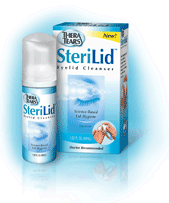How to treat eye allergies

Learn how to get relief from uncomfortable, allergy-ridden eyes
Sneezing and sniffing are tedious symptoms you have to deal with when suffering from allergies. But did you know that symptoms in your eyes are an allergic reaction, too?
Suffering from eye allergies is common – and it’s an uncomfortable, inconvenient experience. In this article, I’ll run you through what you need to know about eye allergies and how best to manage them throughout day-to-day life.
What causes eye allergies?
Like any other allergic reaction, an eye allergy happens when your body overreacts and over-responds. In essence, it’s a symptom associated with your body’s intolerance towards certain triggers or substances.
Environmental factors are most strongly among the common triggers:
- Pollens
- Grass
- Dust mites
- Animal fur
- Cosmetics
Did you know? The thin layer of Conjunctiva that covers your eyes is the same type of membrane that lines the inside of your nose. This means that because these areas are similar in sensitivity and sensation, the same things can trigger an allergic reaction in either place.
Eye allergies can be either seasonal or perennial, meaning you could experience them on a seasonal basis, or year round.
Getting familiar with the symptoms

Your eyes are extremely sensitive towards the environment. With eye allergies, you’re most likely to experience symptoms in both eyes.
Common symptoms include:
- Burning or itchy eyes
- Redness or pinkness
- Swollen and puffy eyelids
- Sensitivity to light
- Blurred vision
- Inflammation
Eye allergies vs conjunctivitis: identifying the difference
It’s important to recognise when your symptoms are corresponding to an allergic reaction in your eyes. But you also need to know when they could mean something a little more serious – in the case you might require urgent medical treatment.
If you regularly experience reactions in your eyes, it can be easy to attribute any discomfort to your usual allergies – so learning the difference is vital.
Bacterial conjunctivitis is a common infection that is easily mistaken for eye allergies due to the symptoms being so similar – but there are a few key differences.
Know when it’s conjunctivitis
Conjunctivitis can often only affect one eye, unlike eye allergies that usually affect both. If you’re experiencing symptoms in one eye only, it could be a strong sign. Another key thing to look out for that can signal conjunctivitis is heavy discharge.
Conjunctivitis is especially common in children and is highly contagious, so ensure you visit the doctor for professional treatment.
Treatment options
- Medications
Oral medications are available over the counter or through a prescription to assist and alleviate symptoms of an allergy. Taking antihistamines is an effective way to help improve your overall symptoms, and they may target your eye irritation as well.
- Lubricant Eye drops
Lubricant eye drops will dilute allergens and smooth out the friction of lids rubbing every time you blink. Taking antihistamines will dry your eyes out too, so a lubricant drop will make your eyes more comfortable. Call in and ask us about which lubricant drops are best suited to you!
- Lid Hygiene

Rinsing your eyes and washing along the lids can make a large difference to the irritating symptoms of eye allergies. We recommend daily use of Sterilid Foaming Lid Cleanser or Optisoothe eyelid wipes. Both of these items are always available in store, and they are our most popular products!
- See a professional
If your symptoms are persistent and you’re not gaining any relief from medications or eye drops, it’s time to talk to the experts! Allergy eye drops are available either over the counter or on prescription. It’s best to come in and we can advise you which should work best for you.
Day-to-day tips to help you protect your eyes
 1.Don’t rub itchy eyes
1.Don’t rub itchy eyes
If you’re experiencing watery, itchy eyes, the worst thing you can do is rub them. This will only further irritate!
2. Wear sunglasses
This will be helpful in preventing pollen from entering your eyes and causing a flare up – especially when you’re spending a lot of time outside in the warmer seasons. When pollen is rich and abundant, sunglasses can be helpful in keeping your eyes a little safer.
3. When driving, keep the windows shut
Limiting your exposure to the environmental elements that worsen your symptoms is key in your protection. Keeping your windows shut when driving will help prevent dust and pollens from flying your way. Use your air conditioner instead!
4. Wash your bedding frequently, and shower at night
Dust mites will settle everywhere. Washing your bedding in hot water every 2 weeks is good practice to minimise dust mite’s invading your safe haven. The same goes for pet fur! Showering at night before going to bed is also great to minimize exposure to allergens.
Talk to us about treatment for your pesky eye allergies!
We’re always here with expert advice and are your go-to for a friendly eye exam. Book an appointment online or phone us on 09 525 1516.
Featured Posts
Focus on Paul Taylor Eyewear
Sometimes we don’t realise that the names behind our favourite brands are actually real people, or that they’re still not only alive but actively designing under the banner of their brand name….
New, Improved Optometry Equipment
Regulars to Greenlane Penrose Optometrist might notice a few changes and improvements during their next eye exam. We’ve been busy setting up new and exciting technology in the practice…
Address
Cnr Great South Road & Rockfield Road, Greenlane 1051
Phone
09 525 1516
Hours
Mon to Fri: 9am – 5pm
Sat to Sun: Closed
Holidays: Closed


